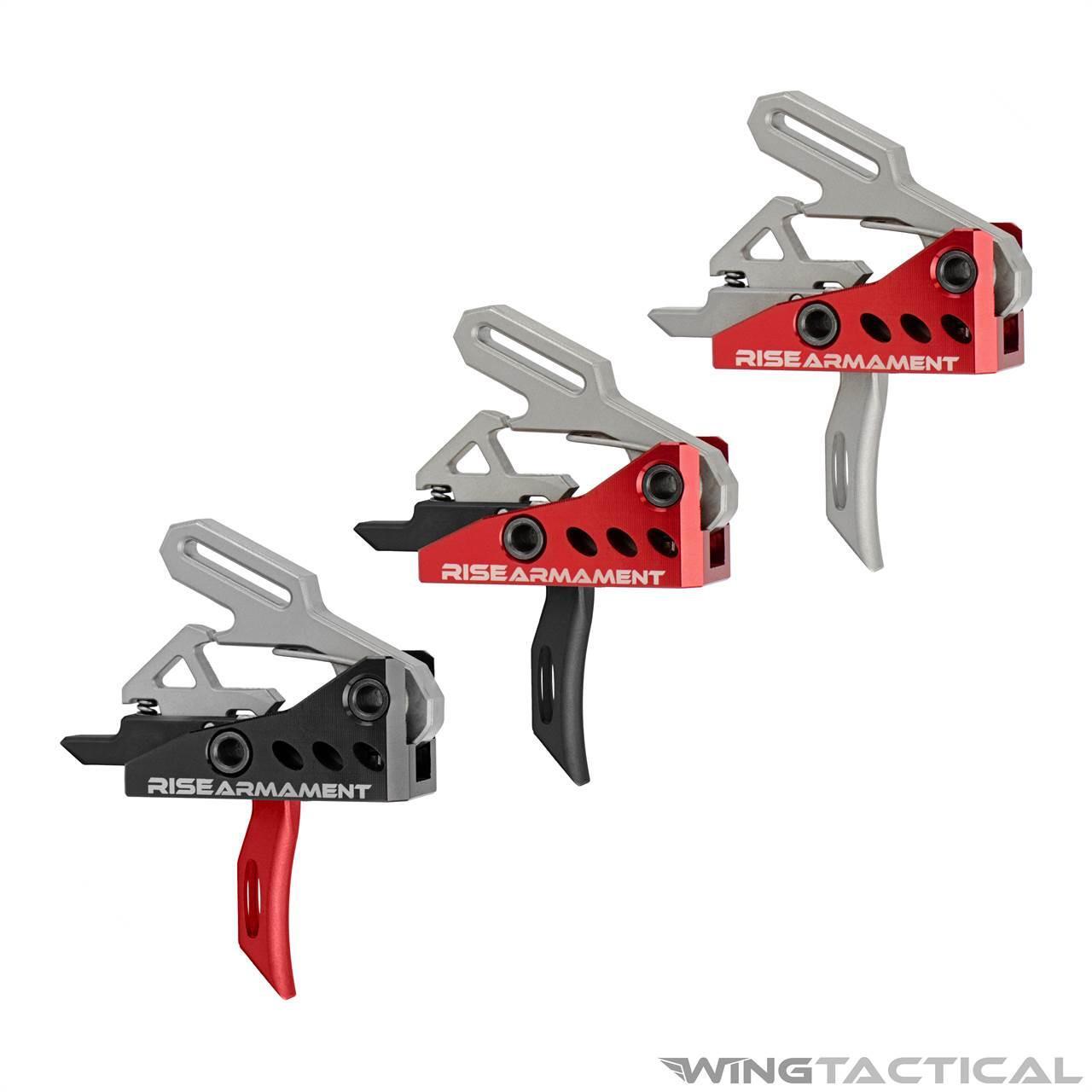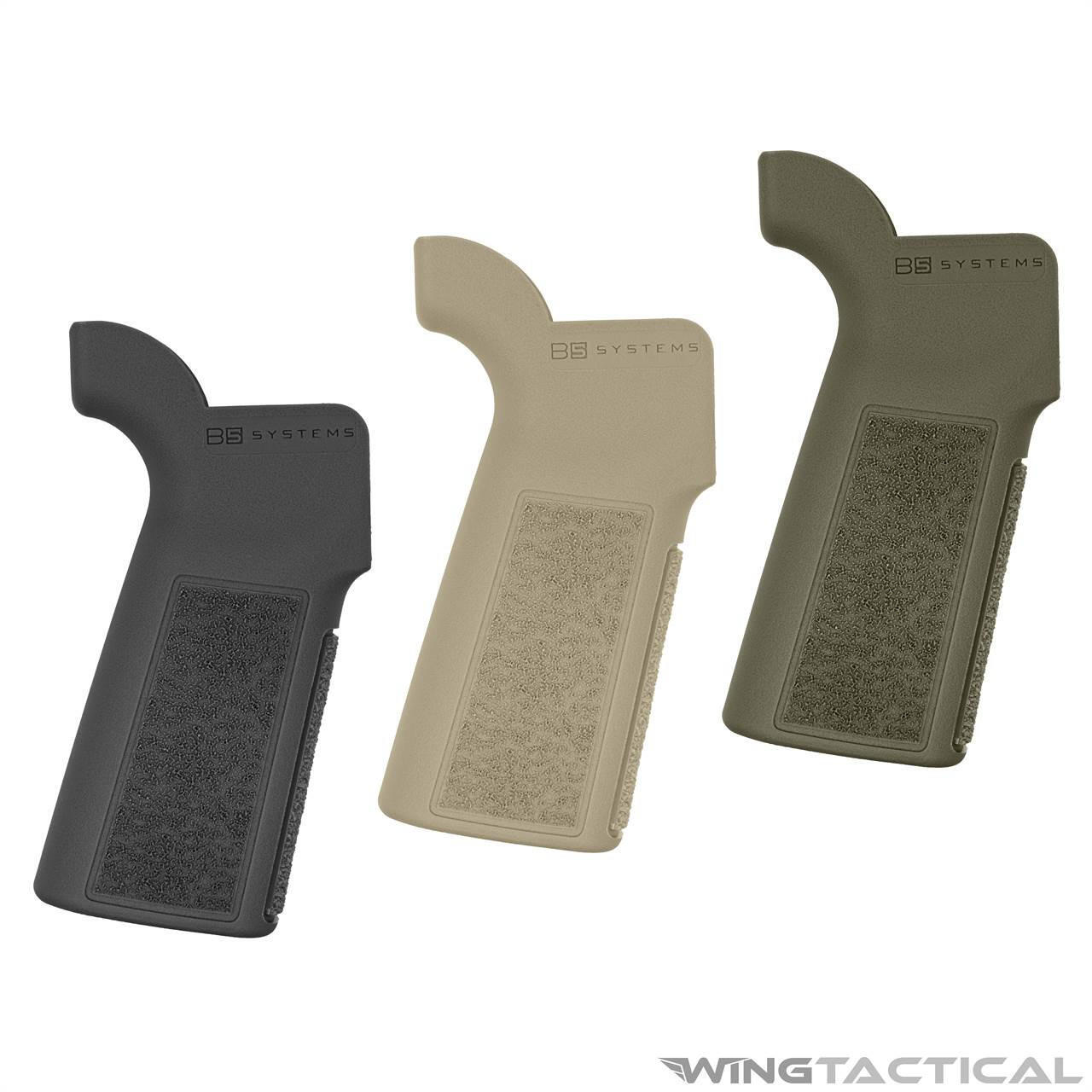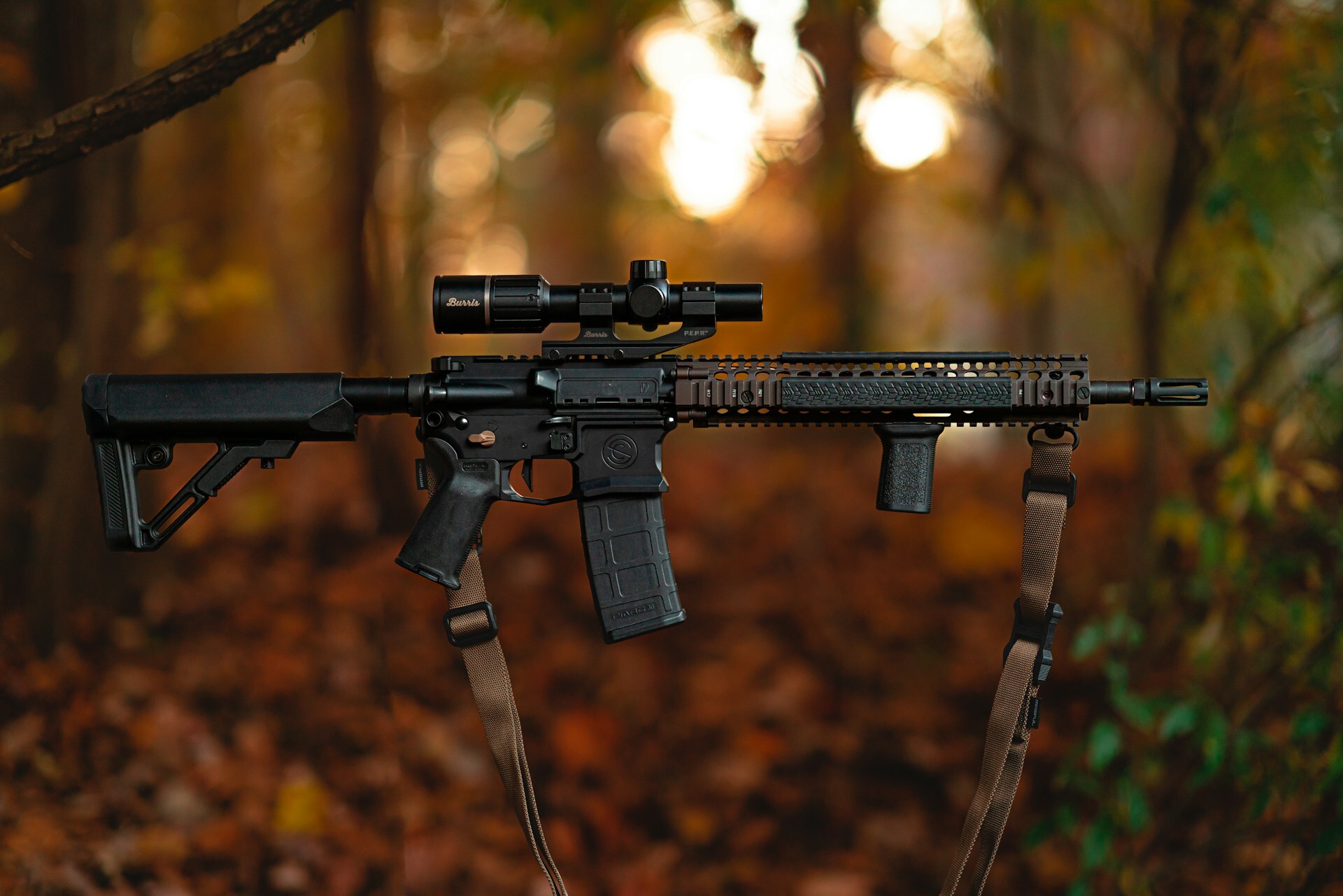- The AR-10 and AR-15 were developed and released in the 1950s with similar designs, making it difficult to differentiate the AR-10 vs. the AR-15.
- Many parts used to create AR-10 and AR-15 rifles are interchangeable, including their pistol grips, trigger springs, and safety selectors.
- Some parts, such as rifle buffers, barrels, and handguards, are not interchangeable in AR-10 and AR-15 rifles.
The AR-10 and AR-15 have historically been two of the most widely used types of rifles for military members. But contrary to popular belief, the AR in their names does not stand for “assault rifle” or “automatic rifle.” Instead, it’s an abbreviation for Armalite Rifle, the firearms manufacturer responsible for developing the original AR platform in the 1950s.
This is one of the many things you should know before buying an AR-10 or an AR-15. You should also realize that when you compare the AR-10 vs. the AR-15, they share quite a few similarities. While there is a difference between an AR-10 and an AR-15, they have many interchangeable parts that should be on your radar from the start.
Before we break down these parts, we should point out that when people refer to the AR-10 these days, they usually aren’t talking about the Armalite AR-10. The term “AR-10” has become the more general name for AR-15-style rifles that chamber in .308 caliber, so to avoid any confusion, we will refer to all .308 AR platform rifles as AR-10s.
We should also point out that, unlike the parts for AR-15s, some AR-10 parts are not interchangeable between brands. Nowadays, Armalite-style and DPMS-style are the two most well-known specifications manufacturers use when making AR-10s, but these are far from the only .308 AR platforms on the market. So when choosing parts for an AR-10, you should first determine which AR-10 style you have to steer clear of getting stuck with the wrong accessories.
Keep this in mind as you read through our AR-10 vs. AR-15 comparison below and see which parts are and are not interchangeable.
Table of Contents
- What's the Difference Between AR-15 and AR-10
- AR-15/AR-10 Compatibility
- Compatible Parts
- Parts that are NOT Compatible
- Compatibility List
- Find Your Needed Parts at Wing Tactical
AR-10 Basics
The original AR-10 was developed and released before the AR-15. It was introduced in 1956, and one of the first things users noticed after picking it up for the first time was that it was surprisingly lightweight compared to other .308 semi-automatic rifles. Its direct impingement design made it lighter than rifles that relied on a piston-driven design. AR-10s typically weigh between 7.25 and 8.9 pounds, depending on the model.
Here are other features that set the AR-10 apart from the beginning:
- Ability to accept detachable magazines
- Adjustable front sight for accuracy at elevation
- Adjustable rear sight for windage
- Aluminum alloy receiver
- In-line stock and pistol grip
The AR-10 also has a top Picatinny rail, offering the perfect mounting solution for various scopes, red dots, and holographic sights.

AR-15 Basics
Developed and released in 1958, the original AR-15 was a modified version of the AR-10. It was lighter than the AR-10, with models weighing 5.5 to 8.5 pounds. Thanks to its lightweight design, users could maneuver quickly with one in their hands, which was seen as a major benefit by those comparing the AR-10 vs. the AR-15 at the time.
The AR-15 also offered users other advantages. It was—and still is—chambered in 5.56 NATO/.223 Remington, allowing users to carry more rounds than those who depended on the larger and heavier .308 WIN. Numerous magazine manufacturers devised ways to increase magazine capacity to 100-plus rounds for the AR-15. Additionally, the AR-15 provided a softer recoil, enabling users to enjoy quicker and more accurate follow-up shots with their rifles.
What Is the Biggest Difference Between an AR-10 and an AR-15?
A few key things separate the AR-10 vs. the AR-15. For example, the lower receiver on the AR-10 is larger than on the AR-15, accounting for its heavier weight. The AR-10 also has more space between its pistol grip and the edge of its lower receiver, and its magazine walls are bigger than the AR-15’s magazine walls to accommodate its larger rounds.
Still, the most significant difference between an AR-10 and an AR-15 is their calibers. The AR-10 uses the .308/7.62x51 cartridge, while the AR-15 uses the .223/5.56x45 cartridge.

AR-10 vs. AR-15 Compatibility
Despite the differences between the AR-10 and AR-15, their similar designs make many parts interchangeable. This has changed a bit in recent years, as many manufacturers—Armalite, Black Rain Ordnance, and Seekins Precision, to name just a few—now produce AR-10 and AR-15 rifles with unique designs and parts that are incompatible from one manufacturer to the next.
However, there is still some crossover, as you will see when comparing AR-10 vs. AR-15 models. Check out the parts that are—and are not—compatible between the AR-10 and AR-15.
Parts That Are Usually Compatible Between the AR-10 and AR-15
Although there is a difference between an AR-10 and an AR-15, the following parts in these rifles remain interchangeable.
- Buttstock assemblies
- Triggers and trigger springs
- Bolt catch roll pin (Armalite-style only)
- Hammers and hammer springs
- Pistol grips (spacers necessary for certain models)
- Receiver extension (buffer tube)
- Disconnector and disconnector spring
- Buffer detent
- Magazine release buttons and springs
- Safety selectors
 |
 |
 |
Parts That Are Typically Not Compatible Between the AR-10 and AR-15
Unfortunately, not all parts are interchangeable between the AR-10 and AR-15. Even some parts that look identical to the naked eye when comparing the AR-10 vs. the AR-15 may not match perfectly. Examples include:
- Rifle buffers: Most AR-10 rifle buffers are shorter and heavier than those found in the AR-15 to accommodate the longer .308 bolt carrier group and the force from a larger round. However, the buffer tubes are the same length, making them compatible with either rifle. It should be noted that the buffer tube for the Armalite-style AR-10 collapsible stock carbine features a unique length and only works with this model.
- Barrels: Because the AR-10 and AR-15 are chambered in different calibers, their barrels, barrel threads, and barrel nut extensions are not interchangeable.
- Handguards and rail systems: AR-10 and AR-15 handguards and rail systems are not interchangeable because of the differences between their barrel nut sizes.
- Bolt catches: An AR-15 bolt catch is incompatible with most AR-10 lowers.
- Lower parts kits: A standard lower parts kit for an AR-15 will normally not work with an AR-10 due to differences in the takedown pin, bolt catch, and other lower receiver pins.
- Magazine catches: The magazine catch in the Armalite AR-10 features a unique design that makes it incompatible with the AR-15 or any other AR model. A standard AR-15 magazine catch will fit a DPMS-style AR-10.
- Muzzle devices: Most AR-10 and AR-15 muzzle devices are not interchangeable, except if your AR-15 is chambered in 300 Blackout. In this case, you can use AR-10 muzzle devices.
Complete List of Compatibility Between AR-15 and AR-10 Parts
These detailed charts break down the compatibility between AR-10 vs. AR-15 parts.
| Mil-Spec AR-15 Upper Receiver Parts | DPMS Style .308 AR | Armalite Style .308 AR |
| Upper Receiver | NOT Compatible | NOT Compatible |
| Charging Handle | NOT Compatible | NOT Compatible |
| Ejection Port Cover Assembly | NOT Compatible | NOT Compatible |
| Forward Assist Assembly | YES | YES |
| Detachable Front Sight | YES | YES |
| Detachable Rear Sight | YES | YES |
| Barrel | NOT Compatible | NOT Compatible |
| Barrel Nut | NOT Compatible | NOT Compatible |
| Handguard | NOT Compatible | NOT Compatible |
| Gas Tube | YES | YES |
| Gas Block | YES | YES |
| Gas Tube Roll Pin | YES | YES |
| Muzzle Device | NOT Compatible | NOT Compatible |
| Muzzle Timing Device (Crush Washer, Lock Nut, etc.) | NOT Compatible | NOT Compatible |
| Bolt Assembly | NOT Compatible | NOT Compatible |
| Bolt Carrier | NOT Compatible | NOT Compatible |
| Mil-Spec AR-15 Upper Receiver Parts | DPMS Style .308 AR | Armalite Style .308 AR |
| Lower Receiver | NOT Compatible | NOT Compatible |
| Trigger | YES | YES |
| Hammer | YES | YES |
| Trigger and Hammer Springs | YES | YES |
| Trigger and Hammer Pins | YES | YES |
| Disconnect | YES | YES |
| Disconnect Spring | YES | YES |
| Bolt Catch | NOT Compatible | NOT Compatible |
| Bolt Catch Roll Pin | NOT Compatible | YES |
| Bolt Catch Spring and Plunger | YES | YES |
| Magazine | NOT Compatible | NOT Compatible |
| Magazine Catch | YES | NOT Compatible |
| Magazine Release Button | YES | YES |
| Magazine Release Spring | YES | YES |
| Pistol Grip | YES | YES |
| Pistol Grip Screw and Washer | YES | YES |
| Pivot Pin | NOT Compatible | NOT Compatible |
| Takedown Pin | NOT Compatible | NOT Compatible |
| Takedown and Pivot Pin Spring | YES | YES |
| Takedown and Pivot Pin Detent | YES | YES |
| Safety Selector (Fire Control Selector) | YES | YES |
| Safety Selector Spring and Detent | YES | YES |
| Trigger Guard Assembly | YES | YES |
| Buffer Tube (Receiver Extension Tube) | YES | YES |
| Buffer | NOT Compatible | NOT Compatible |
| Buffer Retainer | YES | YES |
| Buffer Retainer Spring | YES | YES |
| Buffer Spring (Action Spring) | NOT Compatible | NOT Compatible |
| Receiver End Plate | YES | YES |
| Castle Nut (Receiver Extension Nut) | YES | YES |
| Buttstock | YES | YES |

Find High-Quality AR-10 and AR-15 Parts at Wing Tactical
Wing Tactical is your go-to source for various AR-10 and AR-15 parts, including interchangeable parts like pistol grips, trigger springs, safety selectors, and more. All parts come from top firearms manufacturers to ensure the highest possible quality, and we only sell brand-new products that we would use ourselves.
You can also count on Wing Tactical to supply world-class customer service and deliver next-day shipping to ensure our customers get the parts they need quickly. We even extend full refunds to anyone who isn’t completely satisfied with our parts as long as they are returned within 30 days.
Shop for parts for an AR-10 vs. an AR-15 or vice versa by searching our gigantic inventory of interchangeable parts.
